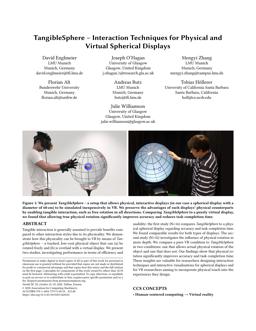TangibleSphere – Interaction Techniques for Physical and Virtual Spherical Displays
Tangible interaction is generally assumed to provide benefits compared to other interaction styles due to its physicality. We demonstrate how this physicality can be brought to VR by means of TangibleSphere – a tracked, low-cost physical object that can (a) be rotated freely and (b) is overlaid with a virtual display. We present two studies, investigating performance in terms of efficiency and usability: the first study (N=16) compares TangibleSphere to a physical spherical display regarding accuracy and task completion time. We found comparable results for both types of displays. The second study (N=32) investigates the influence of physical rotation in more depth. We compare a pure VR condition to TangibleSphere in two conditions: one that allows actual physical rotation of the object and one that does not. Our findings show that physical rotation significantly improves accuracy and task completion time. These insights are valuable for researchers designing interaction techniques and interactive visualizations for spherical displays and for VR researchers aiming to incorporate physical touch into the experiences they design.
Publikation
 |
David Englmeier, Joseph O'Hagan, Mengyi Zhang, Florian Alt, Andreas Butz, Tobias Höllerer und Julie Williamson. TangibleSphere – Interaction Techniques for Physical and Virtual Spherical Displays. In Proceedings of the 11th Nordic Conference on Human-Computer Interaction. NordiCHI '20. ACM, New York, NY, USA. [Download Bibtex] |